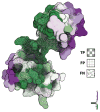Visualizing Validation of Protein Surface Classifiers
- PMID: 25342867
- PMCID: PMC4204728
- DOI: 10.1111/cgf.12373
Visualizing Validation of Protein Surface Classifiers
Abstract
Many bioinformatics applications construct classifiers that are validated in experiments that compare their results to known ground truth over a corpus. In this paper, we introduce an approach for exploring the results of such classifier validation experiments, focusing on classifiers for regions of molecular surfaces. We provide a tool that allows for examining classification performance patterns over a test corpus. The approach combines a summary view that provides information about an entire corpus of molecules with a detail view that visualizes classifier results directly on protein surfaces. Rather than displaying miniature 3D views of each molecule, the summary provides 2D glyphs of each protein surface arranged in a reorderable, small-multiples grid. Each summary is specifically designed to support visual aggregation to allow the viewer to both get a sense of aggregate properties as well as the details that form them. The detail view provides a 3D visualization of each protein surface coupled with interaction techniques designed to support key tasks, including spatial aggregation and automated camera touring. A prototype implementation of our approach is demonstrated on protein surface classifier experiments.
Keywords: Categories and Subject Descriptors (according to ACM CCS); J.3.1 [Computer Applications]; Life and Medical Sciences—Biology and Genetics.
Figures







References
-
- Albers D, Dewey C, Gleicher M. Sequence surveyor: Leveraging overview for scalable genomic alignment visualization. IEEE TVCG. 2011 Dec;17(12):2392–2401. 3. - PubMed
-
- Ariely D. Seeing sets: Representation by statistical properties. Psych Sci. 2001;12(2):157–162. 3. - PubMed
-
- Bertin J. Graphics and graphic information processing. Walter de Gruyter; 1981. 3.
-
- Bruls M, Huizing K, Van Wijk J. Data Visualization. Springer; 2000. Squarified treemaps; pp. 33–42. 5.
Grants and funding
LinkOut - more resources
Full Text Sources
Other Literature Sources
